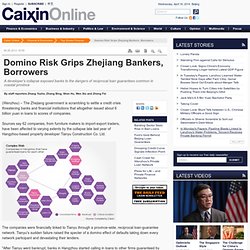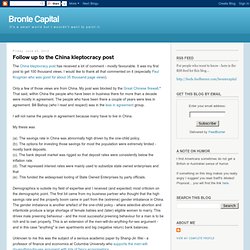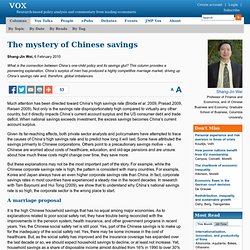

Domino Risk Grips Zhejiang Bankers, Borrowers. A developer's collapse exposed banks to the dangers of reciprocal loan guarantees common in coastal province (Wenzhou) – The Zhejiang government is scrambling to settle a credit crisis threatening banks and financial institutions that altogether issued about 6 billion yuan in loans to scores of companies.

Sources say 62 companies, from furniture makers to import-export traders, have been affected to varying extents by the collapse late last year of Hangzhou-based property developer Tianyu Construction Co. Ltd. The companies were financially linked to Tianyu through a province-wide, reciprocal loan-guarantee network. Tianyu's sudden failure raised the specter of a domino effect of defaults taking down every network participant and devastating their lenders. "After Tianyu went bankrupt, banks in Hangzhou started calling in loans to other firms guaranteed by Tianyu," said the owner of a company tied to the network.
Rescues and Risks Who's to Blame? The Macroeconomics of Chinese kleptocracy. China is a kleptocracy of a scale never seen before in human history.

This post aims to explain how this wave of theft is financed, what makes it sustainable and what will make it fail. There are several China experts I have chatted with – and many of the ideas are not original. The synthesis however is mine. Some sources do not want to be quoted. The macroeconomic effects of the Chinese kleptocracy and the massive fixed-currency crisis in Europe are the dominant macroeconomic drivers of the global economy. China is a kleptocracy. I start this analysis with China being a kleptocracy – a country ruled by thieves. (a). (b). (c). This however is only the beginning of Chinese fraud. China has huge underlying economic growth from moving peasants into the modern economy Every economy that has moved peasants to an export-orientated manufacturing economy has had rapid economic growth.
The one-child policy drives massive savings rates This does not work in China. Follow up to the China kleptocracy post. The China kleptocracy post has received a lot of comment - mostly favourable.

It was my first post to get 100 thousand views. I would like to thank all that commented on it (especially Paul Krugman who was good for about 35 thousand page views). Only a few of those views are from China. My post was blocked by the Great Chinese firewall.* That said, within China the people who have been in business there for more than a decade were mostly in agreement. The people who have been there a couple of years were less in agreement. I will not name the people in agreement because many have to live in China. My thesis was (a).
Demographics is outside my field of expertise and I received (and expected) most criticism on the demographic point. Unknown to me this was the subject of a serious academic paper by Shang-Jin Wei - a professor of finance and economics at Columbia University who supports the men-will-do-anything-for-sex argument with lots of fancy econometrics. In Asia, Complex Securities Gain Favor. The mystery of Chinese savings. Much attention has been directed toward China’s high savings rate (Broda et al. 2009, Prasad 2009, Reisen 2009).

Not only is the savings rate disproportionately high compared to virtually any other country, but it directly impacts China’s current account surplus and the US consumer debt and trade deficit. When national savings exceeds investment, the excess savings becomes China’s current account surplus. Given its far-reaching effects, both private sector analysts and policymakers have attempted to trace the causes of China’s high savings rate and to predict how long it will last. Some have attributed the savings primarily to Chinese corporations. Others point to a precautionary savings motive – as Chinese are worried about costs of healthcare, education, and old-age pensions and are unsure about how much these costs might change over time, they save more.
But these explanations may not be the most important part of the story. Figure 1. The next possibility is far more challenging.